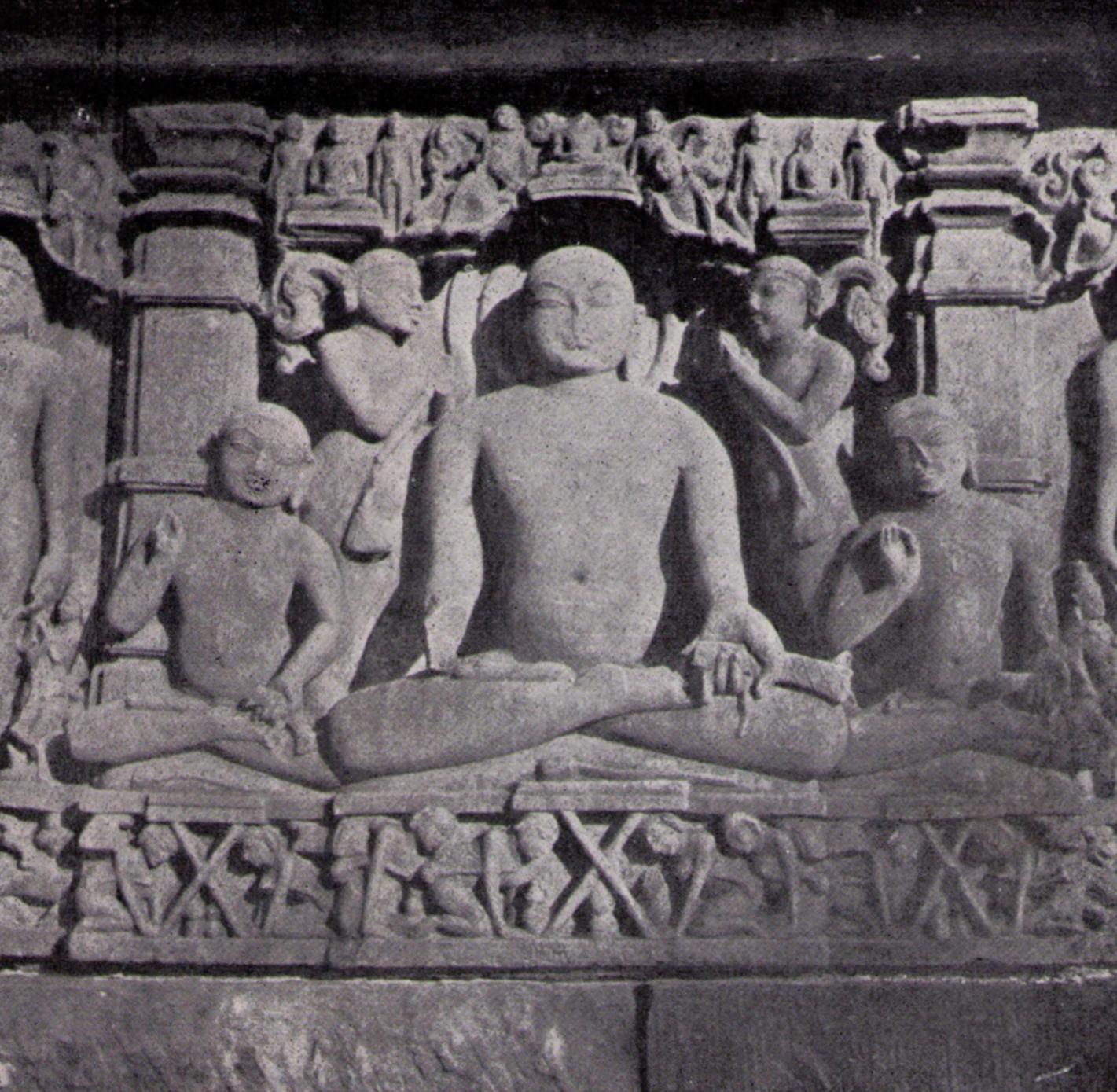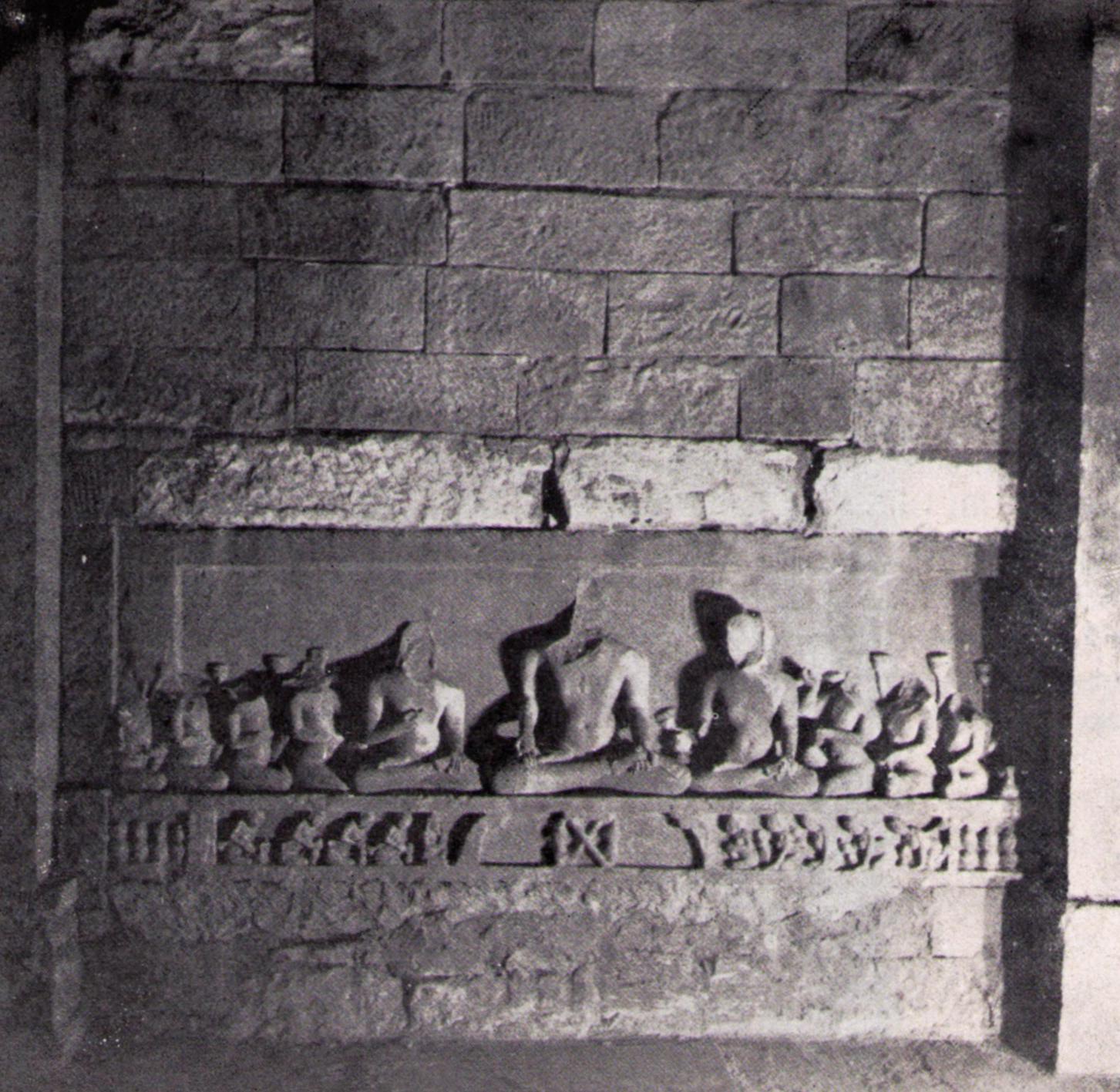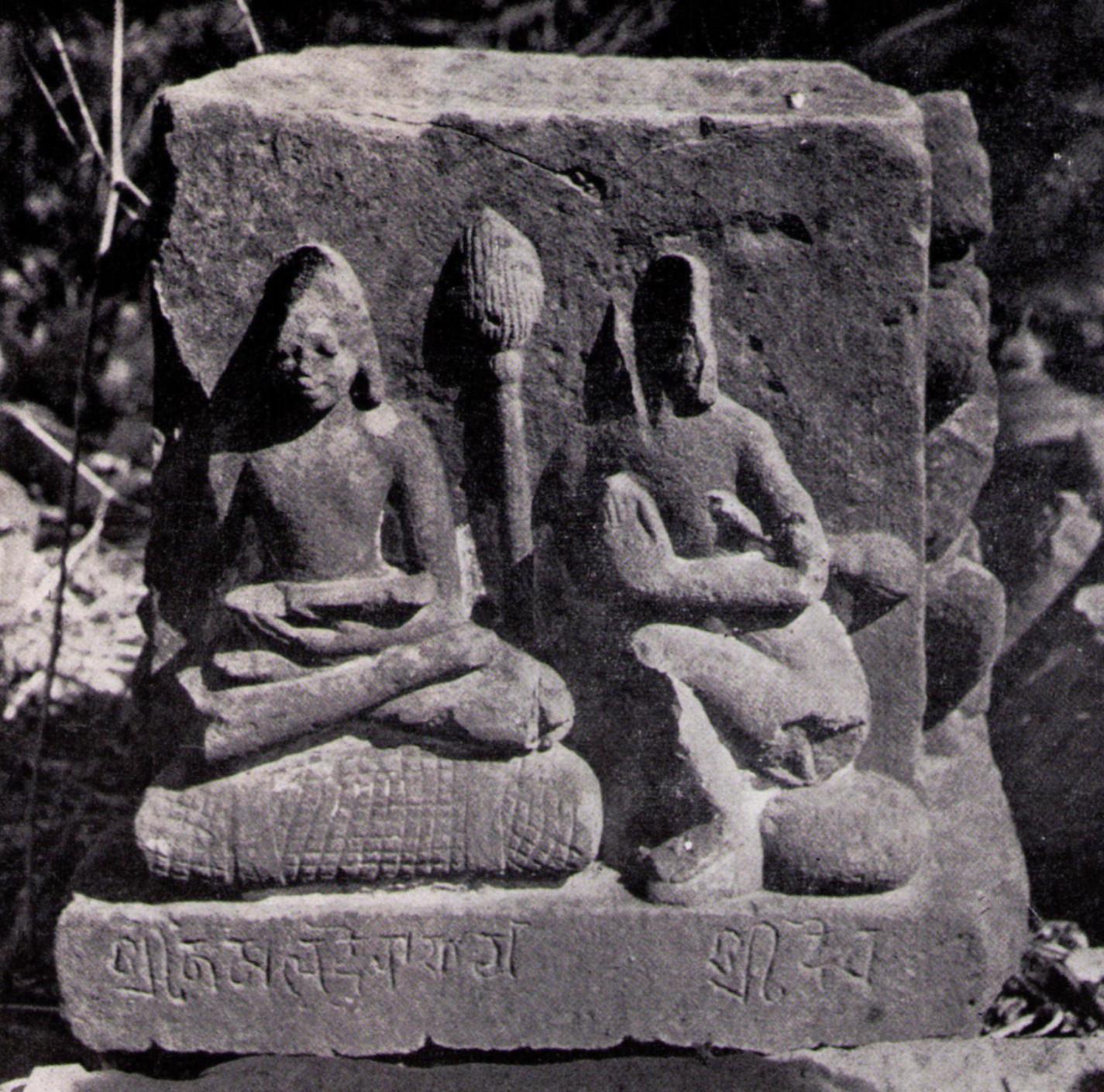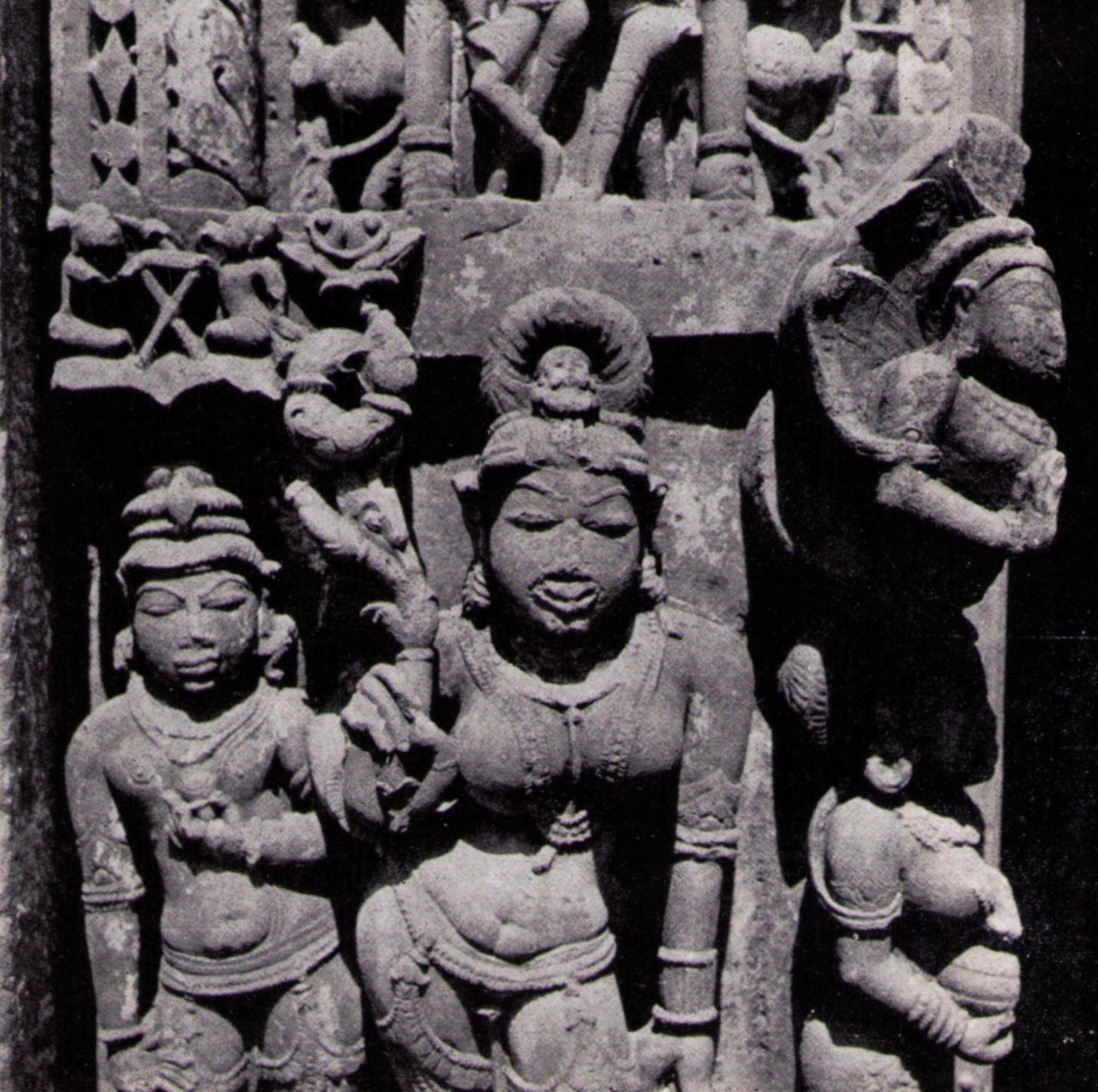
This essay was published at Deyadharma. Studies in Memory of Dr. D.C. Sircar (Ed. by Gouriswar Bhattacharya, Sri Garib Dass Oriental Series No. 33, Delhi: Sri Satguru Publications, 1986, pp. 179-187). To make this online reissue citeable, the page numbers are added to the text (see squared brackets).
The Ācārya Motif at Deogarh
Preliminary Notes
[179] The “ācārya motif” (confined to Deogarh and a few places in its vicinity) is a sub-motif of the more common “teacher-and-disciple motif”. The ācārya motif was popular mainly from ca. 1000 to 1150 A. D.
The reader will notice that the term “canon” is used repeatedly in our paper. It has two different senses: methodic canon (Section 1) and iconographic canon (Section 2). Refer for the concept of “canon” to Assmann 1985/86.
The present paper is closely connected with the Deogarh monograph (1969). The reader is requested to consult the photographs and descriptions given in that study whenever it is necessary. A short description of the Jaina temples of Deogarh will be found in §18 (Chapter 3).
1. Observations on the Method
Indian iconography is complex not only in a general sense but also in so far as different motifs (we are referring mainly to representations of gods, goddesses, etc.) differ as motifs. There are not only “main figures” but also small figures decorating images (mūrtis) and architectural members. The representations of the gods, etc. differ also in their general character: they are not contaminated or contaminated, unequivocal or equivocal, canonized or not canonized, named or unnamed. Besides, temple iconography and book iconography may converge or diverge. These fluctuations necessitate adaptations of the method to the different types of material. It seems unlikely that one and the same methodic strategy can do full justice to artistic concepts of quite different character. Different motifs obviously require different strategies.
Here we have to add that there are further variants, viz. variants concerning the “construction of the subject”. A study may cover five or fifty or hundred and fifty Jinas, it may include or exclude the subsidiary motifs on the images, it may include or exclude compositions other than images (e.g. surfaces covered with small figures), it may include or [179|180] exclude figures without clear literary background, it may include or exclude entire motif systems (such as the cliches in Jaina miniature painting), it may be iconographic or stylistic-cum-iconographic.
It is in the framework of such new options that the differences between the various types of motifs become relevant. And new options concerning the “construction of the subject” necessitate a step-be-step extension of the current methodic canon. The statement can also be reversed: any hesitation to extend this canon will reduce the number of options (canons acting as segregating factors).
The extension of the methodic canon consists of numerous different adjustments. We have to consider the peculiarities of the subject and to select adequate strategies of description, analysis, etc. It is obvious that such an approach is quite different from the employment of a specific method. A method is a self-contained concept and is mostly applied to a wide range of phenomena.
Our object was a comprehensive and systematic study of a widespread motif which has no clear literary background and no uniform appearance. We soon realized that this could only be achieved on the basis of a distinction between “canonical” and “non-canonical” phases in the development of the motif and we therefore selected an important “canonical” phase - the one described in the Preliminary Notes. “Canonical” stands in this case for “uniform”, “regular”. Our treatment can be characterized as systematic, synchronic, and microscopic. The subject constructed by us is a cross-section, a corpus, and a sub-motif. We hope that, on the basis of this examination of a”sub-motif”, further studies which cover the entire motif can be undertaken.
Plate No. 1
2. Description of the Ācārya motif
The teacher-and-disciple motif is widespread in Indian art. Here we are only interested in a certain historical line which started in Pāśupata circles (iconography of Lakulīśa) of the Gupta and post-Gupta periods and ended about thousand years later in numerous popular motifs of Jaina miniature painting in Western India. In between is a long development which is reflected - inter alia - in small compositions appearing on the lower door-jambs of many Hindu and Jaina temples in Madhya Desha. We mention only the Telī-kā Mandir at Gwalior (Viennot 1964, Pl. 32a: Hindu variety of the motif) and the Mālādevi Temple at Gyaraspur (e.g. Viennot 1964, Pl. 29a: Jaina variety). After ca. 1000 A.D., revivals of the motif took place at Deogarh and Khajuraho (see for the latter place Pramod Chandra 1955/56, Figs. 8, 16, etc).
As mentioned already we select from the relevant material a cross-section: Deogarh material from ca. 1000-1150 A.D. as far as it conforms to a particular canon which is most clearly demonstrated by the so-called frieze slabs. Irregular pieces belonging to the said period must be excluded. For technical reasons we have also excluded regular pieces which are earlier than 1000 or later than 1150 A.D. Again it was not possible to consider each and -every occurrence of the motif on the Deogarh doorways. [180|181]
The cross-section or corpus which remains is rather homogeneous. We now use the term “ācārya motif” because the ācārya (spiritual teacher, etc.) is the main theme. The disciples play only a minor part and will be called “monks” (in the sense of ordinary monks). Whenever both types occur in a composition we have to distinguish between “ācāryas” and “monks”. In cases where we mention both types together we say “ācāryas and monks”. The general situation in the ācārya iconography can be summarized as follows:
3. Description of the ācāryas and monks
Ācāryas and monks are represented as naked. The ācāryas are invariably seated; when they are seated in padmāsana their liṅga is invisible, in the case of lalitāsana it is visible. The ācārya holds a book in his left hand, while his right hand is shown without any object. Monks never hold a book. Ācāryas are invariably represented with a “sthāpanā” (wooden stand). In rare cases, the artists indicate that the sthāpanā is covered with a cloth. However, two (or even more) ācāryas may share one sthāpanā. Monks do not have sthāpanās, but in the representations they may be shown near to the sthāpanā of an ācārya. Ācāryas and monks are shown with brooms and alms-bowls. However, in the case of the monks and the less prominent ācāryas (small size representations) brooms and alms-bowls are more conspicuous than in the case of the more prominent ācāryas. There are no face-cloths, rosaries, and no objects placed on the sthāpanās. Ācāryas and monks wear “caps” as it were: this formula is a device to distinguish them from Jinas of the same period who are invariably shown with curly hair. On the whole, one may say that the opposition between ācārya and monk is represented by the artists as an opposition between teacher and adorant-disciple.
Plate No. 2
4. Description of the corpus
Most of the teacher-and-disciple compositions at Deogarh belong to four categories derived from the members (objects) which carry them:
[181|182] There are also a few cases which do not come in these four categories. The present classification according to the "carrier" is introduced as a substitute for a classification-based on intrinsic criteria.
The sequence A-D is chronological. In the following discussion - which is only concerned with the ācārya motif - we shall retain the symbols A-D but change the order. In our context it is necessary to start with the clearest type and to proceed from there to less clear or less paradigmatic examples. Our order and selection is as follows: all the frieze slabs showing the ācārya motif (seven in all); the oblong slab in Temple No. 4; the Jina Image No. 300 in Temple No. 4; six pillar capitals with the ācārya motif. To this we add a discussion of the somewhat irregular representation of the ācārya motif on lower door-jambs (Temples Nos. 5, 12, and 28).
5. The frieze slabs (Type C)
(a) Temple No. 1, parapet, slab fixed on the outer side (our Fig. 1 = Jain/Fischer 1978 Pl. 19b). The main zone (middle zone) shows three ācāryas in hieratic scaling (the ācārya in the centre is larger than the two lateral ācāryas). The right hand displays the teaching gesture in the case of the lateral figures and it is lowered in the case of the central figure. Here and in other cases an identification of the gesture of the “lowered” hand is not possible as it is broken. Each ācārya a has a broom lying before him. The central ācārya is flanked by two standing monks. These monks perform the añjali-gesture and hold their brooms between the palms of their hands. In the lower register (we ignore the upper register) seated monks are seen who bow before the sthāpanās of the three ācāryas. Here the brooms are held in the “outer” arms which are pressed against the bodies (left arm in the case of a figure turned to the left, r. a. in the case of a fig. turned to the right). Alms-bowls are depicted below the sthāpanās.
(b) No. 1, parapet, outer side (Deogarh Fig. 210). Here and in (d-f) the pattern is basically the same as in (a); however, as compared with (a), the monk to the right has been replaced by a male parasol-bearer. The heads of the lateral ācāryas are turned towards the central ācārya. The single standing monk holds the broom under his lower arm which is pressed against his flank so that the liṅga becomes visible. The stylistic standard is lower than in (a) and the rendering of some of the details has become mechanical.
(c) No. 1, parapet, outer side (Bruhn 1956, p. 30, Fig. 4). Here we have no pentad (central ācārya flanked by two-plus-two lateral figures) but merely the nuclear ācārya-triad. The ācārya to the right seems to be slightly smaller than the one to the left. The right hands of the other two ācāryas (left and centre) clearly perform the abhaya gesture. A very prominent vegetable motif (“tree”) is seen to the left of the central ācārya (cf. “g”). The lower register is not symmetrical.
(d) No. 1, parapet, inner side. Very similar to (b). [182|183]
(e) No. 1, interior, loose slab. Very similar to (b).
(f.1 - f.2) No. 1, fragment lying near the temple (f.1); Wall-Section I, fragment (f.2). It is very probable that originally both pieces formed one slab: Very similar to (b). The fragment f.1 shows the ācārya-to-the-right and the parasol-bearer; f.2 accommodates the remaining parts of the composition.
(g) Wall-Section IV, damaged slab. Same type as (c) but no lateral ācārya on the right side and different rendering of the “tree”.
We have merely described the ācārya sections and not the entire slabs (e.g. no reference to the complete sequence - standing Jina, ācāryas, standing Jina - in the case of “a”). On account of the destructions it is as a rule difficult to describe the right hands of all the ācāryas. - The frieze slab iconography marks a departure from the contemporary pantheon iconography (Jaina goddesses and gods). Most of the frieze slab figures are standing and seated Jinas, ācārya compositions are well represented as we have just seen, and there are two Bharatas and two Bāhubalis. However, we notice only a single goddess (Sarasvatī, the “Śrutadevatā” of the Jainas). See Tiwari 1973, pp. 352-53 (Bāhubali) and 1974, pp. 41-42 (Sarasvatī). The two brothers Bharata and Bāhubali and the Śrutadevatā are standing figures. The pattern of all the slabs is very similar. As a consequence, one and the same place in a composition may be occupied by an “ācārya attribute” (element going with an ācārya) in the case of an ācārya, and by a “Jina attribute” in the case of a Jina. There is for example a miniature Jina above an ācārya and a triple parasol-top with drum and drummer above a Jina (see Deogarh Fig. 210). For such comparisons we can also use the terms “slot” (in our example the place above the head of the main figure) and “filler” (miniature Jina versus parasol-top). Slot-filler analysis can be used for contrasting studies (Jina versus ācārya) and - more particularly - for the study of individual types (Jina image x versus Jina image y). The extent (and form) of application will, however, change from case to case.
Plate No. 3
6. An oblong slab in Temple No. 4 (Type B)
The present slab (Fig. 2) is inserted into the inner wall of Temple No. 4 (the wall to the right, as one enters). The composition is closely related to those on the frieze slabs but the format is different (oblong). There is again an ācārya-triad in the centre (the lowered hand of the central ācārya performs the varada gesture). But four additional ācāryas appear to the left and to the right of the central triad. It would appear that all these eight figures (but not the three figures in the middle) have “standing” brooms. There is one single sthāpanā for all the eleven ācāryas. It seems that the ten figures in the lower register (five turned towards the right, and five towards the left) represent the fourfold congregation. We see (from left to right) 4 monks, 1 lay-follower (male), 1 lay-follower (female), 4 nuns. Nuns belong to a late stage in the development of the ācārya motif and have therefore not been mentioned in Section 2. [183|184]
7. Jina image with two ācāryas (No, 300)
This image (Deogarh § 214, Figs. 231-33) belongs to the tritīrthika variety. Besides, there is a departure from the usual pattern of the Jina images: a large horizontal zone is intercalated between the Jinas and the pedestal. The central portion of this additional zone accommodates two ācāryas facing each other and separated by a sthāpanā. This is the formula of the lower door-jambs: “ācārya-sthāpanā-ācārya” (ācāryas shown from the side) - and not “ācārya-cum-sthāpanā” (ācārya shown from the front). The sthāpanā is provided with a cloth (depicted as hanging down behind it).
8. The pillar capitals (Type D)
Out of the four faces of a capital, one (or two) may be occupied by an ācārya. The remaining faces will be occupied by Jinas. However, one capital (f) has an ācārya on one side and three Jaina goddesses on the remaining sides.
(a) Capital fixed upon the Wall (outer wall-Section V = inner W.- S. XII). Richly decorated capital. In principle, any separate “capital” may be explained as a mere caumukha, but we call such pieces “capitals” unless there is proof to the contrary. The ācārya is seated in lalitāsana. He has curly hair like the Jinas (to my knowledge this is the only instance of this type at Deogarh). A tiny sthāpanā appears below him and there are two small adorants in the lower corners.
(b-c) Two ācārya panels on two pillars showing the same design and standing near Temple No. 1 (“medium-sized type”: Deogarh § 18.1). The panels follow the general pattern ("a-e") and the ācārya figures have been distinguished effectively from the contemporary Jina figures. The hands of the ācārya are preserved (teaching-gesture and book). It seems that all the four attributes are depicted (book/sthāpanā/broom/alms-bowl). No adorants.
(d) Pillar dated samvat 1207 and used for the construction of the porch of Temple No. 4 (Deogarh Fig. 269). The small adorant in the lower corner (to the right) is a monk with broom and alms-bowl.
(e) Capital fixed upon the wall (outer Wall-Section II = inner W.-S. XV: Deogarh Fig. 266). The rendering is conventional. The lower register shows a sthāpanā flanked by two monks. As shown in Sect. 5, monk(s)-sthāpanā-monk(s) is the standard motif in the lower registers of Type C. There is, however, a difference between “joining the open hands together” (añjali) and “hands placed on the ground”. The lower register of (e) follows the first formula.
(f) Capital lying near Temple No. 12 amongst the debris which are scattered over the area to the west of the “Fort wall” (Deograh Fig. 1: plan). The ācārya (inscription: śrī Kamaladevācārya) is seated in padmāsana - liṅga not visible - and his broom is “standing”. The adorant to the right (śrī-Deva) is a monk holding the broom under his left arm. Ācārya and monk have the same sizes and are seated on cushions. See Fig. 3. [184|185]
Plate No. 4
9. Lower door-jambs (Type A)
Many Jaina temples at Deogarh show ācārya motifs on their lower door-jambs. The motifs in general and the individual figures in particular are not in complete agreement with the ācārya motif as discussed in Sections 5-8. In order to indicate the difference we put the word “ācārya” in the present section always in quotation-marks. No doubt, the influence of the Deogarh vocabulary (Sections 5-8) is strong, but the door-jambs have their own conventions both in iconography (Hindu influence or Hindu substratum) and style (general plan, vocabulary, artistic licences). The result can be described as a compromise. The following description will also show that certain rules are observed. In relation to Sections 5-8 we would classify this material as “semi-canonical”.
All the figures are “ācāryas”. They are naked, seated, and shown from the side. The sthāpanā is a frequent feature but it is missing in a number of cases. The broom is a conspicuous element, rarely missing, and depicted in many different ways. The book does not seem to be very common. Occasionally we come across details which are absent in the material of Sections 5-8. The attitudes of the “ācāryas” are subject to change within the limits of the relevant door-jamb conventions (“seated and shown from the side”). The brooms are held in different ways, the books are held in the ”inner” hands. (See Section 5a). The “outer” hands are almost always empty. The description of the entire compositions will be facilitated by the following list of formulas:
We have noticed the “ācārya” motif on eight different doorways belonging to Deogarh Temples Nos. 5, 11, 12, 18, and 28. The doorway of Temple No. 19 is earlier than the rest and the two panels on the jambs show Hindu ascetics according to formula (ii): ascetic-ascetic. Below we supply the data for the five doorways of Temples Nos. 5, 12, and 28. The following abbreviations will be used: LJ and RJ (lower door-jambs to the left and to the right), in and ex (inner and outer doorways), e and w (eastern and western doorways). Formulas (iii) and (iv) are part and parcel of the decorative zone above the river-goddess (lotus-parasol and scroll-work). Formulas (i) and (ii) occupy separate places on the outer margins. [185|186]
Temple No. 5 (dated samvat 1120). LJ-e has both formulas, “ācārya”-”ācārya” and “ācārya”-parasol-”ācārya”. RJ-e and LJ-w have “ācārya”-sthāpanā-”ācārya”. See Deogarh Fig. 291 for RJ-e. The right-hand “ācārya” of RJ-e is shown with yogapaṭṭa: the element in question is a true yogapaṭṭa and not a stylized broom. There is no “ācārya” motif on RJ-w.
Temple No. 12. In the Middle Ages, the original doorways of this temple have been replaced by new ones. The inner doorway is dated samvat 1051, and the outer doorway samvat 1133. See Deogarh p. 36 for details. The damage suffered by the lower door-jambs is considerable. We assume that there were originally three “ācāryas” in all the four cases (Deogarh Fig. 249). But closer examination of the surfaces may show that the complete formula “ācārya” - parasol - ”ācārya” - “ācārya” cannot be postulated for all the four jambs. See Deogarh Figs. 196 (RJ-in; Viennot 1964, Pl. 46a), 249 (LJ-ex), and 292 (LJ-ex). It seems that the general concept was “books in the inner hands/outer hands rested on the ground or on the knees (outer arms stretched)”. Before the left-hand “ācārya” of RJ-in, an alms-bowl is depicted (Deogarh Fig. 196). The left-hand “ācārya” of LJ-ex holds a broom in his outer hand (Deogarh Fig. 292, hardly visible). The right-hand “ācārya” of LJ-ex has obviously placed his broom on his lap: this gives the impression that the artist indicated the upper border of a lower garment (Deogarh Fig. 292, hardly visible).
Temple No. 28 (not dated). Both door-jambs show the formula “ācārya” - sthāpanā - ”ācārya” (see Fig. 4 for LJ). The “sthāpanā” of RJ has vertical legs. Again, the “ācārya” to the left holds his broom in such a way before the “sthāpanā” that the broom looks like a horizontal division of the “sthāpanā”.
Some teacher-and-disciple motifs on Hindu temples show points of agreements with our “ācārya” motif. The left door-jamb of a temple at Pali (Viennot 1964, Pl. 41a) has a complex motif which includes a teacher-sthāpanā-teacher group (otherwise the sthāpanā is not found in Hindu iconography). A left door-jamb “from central India” (London 1982, Fig. 74) has a single seated teacher shown from the side. The teacher holds a book with akṣara marks in his inner hand (left hand) while his outer hand is rested on the ground.
Bibliography
 Prof. Dr. Klaus Bruhn
Prof. Dr. Klaus Bruhn



